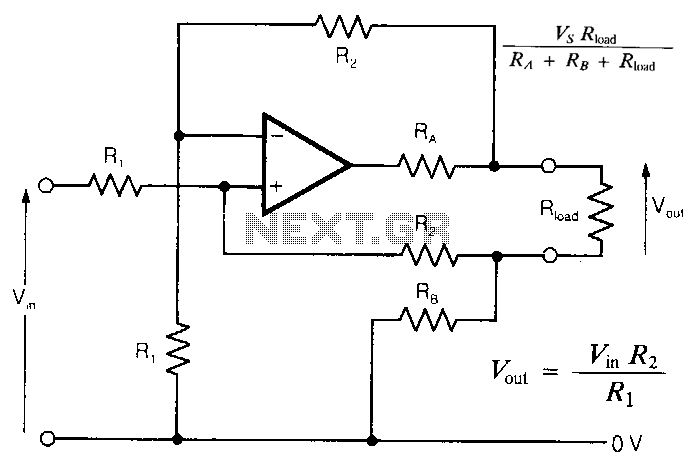
Safe-opamp-circuit

In intrinsically safe applications, it is sometimes necessary to separate sections of circuitry using resistors that limit current under fault conditions. The circuit presented offers an accurate analog output with effectively zero output impedance, despite the presence of resistors in series with the output, which remains independent of RA and RB. The values of RA and RB should be selected to achieve the desired current limiting; however, it is important to note that a portion of the voltage at the op-amp output will be dropped across these resistors. Any type of operational amplifier would be suitable for this configuration.
In intrinsically safe designs, ensuring the safety and reliability of electronic circuits is paramount. The circuit described utilizes resistors to create a barrier that limits current flow in the event of a fault, thus preventing potential hazards. This is particularly critical in environments where explosive gases or flammable materials may be present.
The operational amplifier (op-amp) serves as the core component of the circuit, providing amplification and signal conditioning. The selection of the op-amp should consider factors such as bandwidth, power supply requirements, and input/output characteristics to ensure optimal performance in the specific application.
The resistors RA and RB are integral to the current limiting functionality. Their values must be carefully calculated based on the maximum allowable current for the application and the specific characteristics of the load being driven. It is essential to account for the voltage drop across these resistors, as this drop will affect the output voltage available at the op-amp's output terminal.
To maintain an effective output impedance close to zero, the design may incorporate a feedback mechanism that compensates for any voltage loss caused by RA and RB. This can be achieved through appropriate feedback network design, ensuring that the output remains stable and accurate across varying load conditions.
In summary, this circuit design emphasizes the importance of safety in hazardous environments while maintaining performance integrity. The careful selection of components and values within the circuit ensures both safety and functionality, making it suitable for a range of intrinsically safe applications.In intrinsically safe applications, it is sometimes necessary to separate sections of circuitry by resistors which limit current under fault conditions. The circuit shown provides an accurate analogue output with effectively zero output impedance, despite having resistors in series with the output.
which is independent of RA and RB. The values of RA and RB should be chosen to achieve the desired current limiting, but note that a proportion of the voltage given at the op-amp output will be dropped across these resistors. Any type of op amp would be suitable. 🔗 External reference
In intrinsically safe designs, ensuring the safety and reliability of electronic circuits is paramount. The circuit described utilizes resistors to create a barrier that limits current flow in the event of a fault, thus preventing potential hazards. This is particularly critical in environments where explosive gases or flammable materials may be present.
The operational amplifier (op-amp) serves as the core component of the circuit, providing amplification and signal conditioning. The selection of the op-amp should consider factors such as bandwidth, power supply requirements, and input/output characteristics to ensure optimal performance in the specific application.
The resistors RA and RB are integral to the current limiting functionality. Their values must be carefully calculated based on the maximum allowable current for the application and the specific characteristics of the load being driven. It is essential to account for the voltage drop across these resistors, as this drop will affect the output voltage available at the op-amp's output terminal.
To maintain an effective output impedance close to zero, the design may incorporate a feedback mechanism that compensates for any voltage loss caused by RA and RB. This can be achieved through appropriate feedback network design, ensuring that the output remains stable and accurate across varying load conditions.
In summary, this circuit design emphasizes the importance of safety in hazardous environments while maintaining performance integrity. The careful selection of components and values within the circuit ensures both safety and functionality, making it suitable for a range of intrinsically safe applications.In intrinsically safe applications, it is sometimes necessary to separate sections of circuitry by resistors which limit current under fault conditions. The circuit shown provides an accurate analogue output with effectively zero output impedance, despite having resistors in series with the output.
which is independent of RA and RB. The values of RA and RB should be chosen to achieve the desired current limiting, but note that a proportion of the voltage given at the op-amp output will be dropped across these resistors. Any type of op amp would be suitable. 🔗 External reference